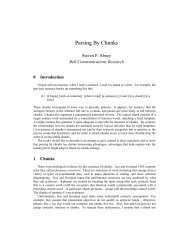The English Noun Phrase in its Sentential Aspect - Vinartus
The English Noun Phrase in its Sentential Aspect - Vinartus
The English Noun Phrase in its Sentential Aspect - Vinartus
Create successful ePaper yourself
Turn your PDF publications into a flip-book with our unique Google optimized e-Paper software.
42 CHAPTER 2. NOUN PHRASE AND SENTENCEappear <strong>in</strong> all languages. Some languages lack <strong>English</strong>-type adjectives, ornearly so (Swahili is a famous example). Other languages appear to lacka separate class of adpositions, us<strong>in</strong>g nouns <strong>in</strong>stead (the Mayan languages,for <strong>in</strong>stance).Further, there are two dist<strong>in</strong>ct categories, with very dierent syntacticproperties, which meet notional criteria of adjective-hood (i.e., they typicallydenote physical attributes, emotional states, etc.). In some languages,\adjectives" (<strong>in</strong> the notional sense) are syntactically very similar to|evena subcategory of|verbs <strong>in</strong> other languages they behave syntactically likenouns. Many languages have both syntactic types, with a preponderanceof one or the other. 10 It appears, then, that there are at least two syntacticcategories that are notionally adjectives, one essentially nom<strong>in</strong>al ([+N]),as <strong>in</strong> <strong>English</strong>, and one essentially verbal ([-N]). If so, and if both syntactictypes of adjective constitute major categories, then we have ve majorcategories, not four.<strong>The</strong>se are my reasons for be<strong>in</strong>g skeptical of the standard [NV] categorytetrachotomy. I do not claim that I haveproven <strong>in</strong> this brief discussionthat there is no feature [V] nonetheless, I do not adopt it. I do assumenouns are dist<strong>in</strong>guished from adjectives, and prepositions are dist<strong>in</strong>guishedfrom verbs, but I do not assume that these two dist<strong>in</strong>ctions necessarily haveanyth<strong>in</strong>g <strong>in</strong> common.I assume two major features, [F], [N], which dene four major classesof syntactic categories. 11 I also assume that there are m<strong>in</strong>or features thatdist<strong>in</strong>guish subclasses of syntactic categories, but I will not argue here fora particular set of m<strong>in</strong>or features. Unless a given m<strong>in</strong>or feature cuts acrossmajor syntactic-category classes, the question of the identity of the m<strong>in</strong>orfeatures is not very <strong>in</strong>terest<strong>in</strong>g. (A candidate for a m<strong>in</strong>or feature whichcuts across major syntactic-category classes is that which dist<strong>in</strong>guishesnouns and adjectives. In section IV-3, I exam<strong>in</strong>e the possibility that thisfeature also dist<strong>in</strong>guishes between ma<strong>in</strong> verbs and auxiliaries: i.e., thatN:A::V:Aux.)<strong>The</strong> four major classes of syntactic categories are as follows:10 See Dixon (1982) for a detailed notional characterization of \adjective" and a surveyof language types with regard to the syntactic expression of \adjective" notions.11 I do not assume that categories are necessarily dened by their feature compositions.I assume that features dene classes of categories, but I leave open the question whetherit is possible for two categories to have all feature specications <strong>in</strong> common, yet rema<strong>in</strong>dist<strong>in</strong>ct categories.



